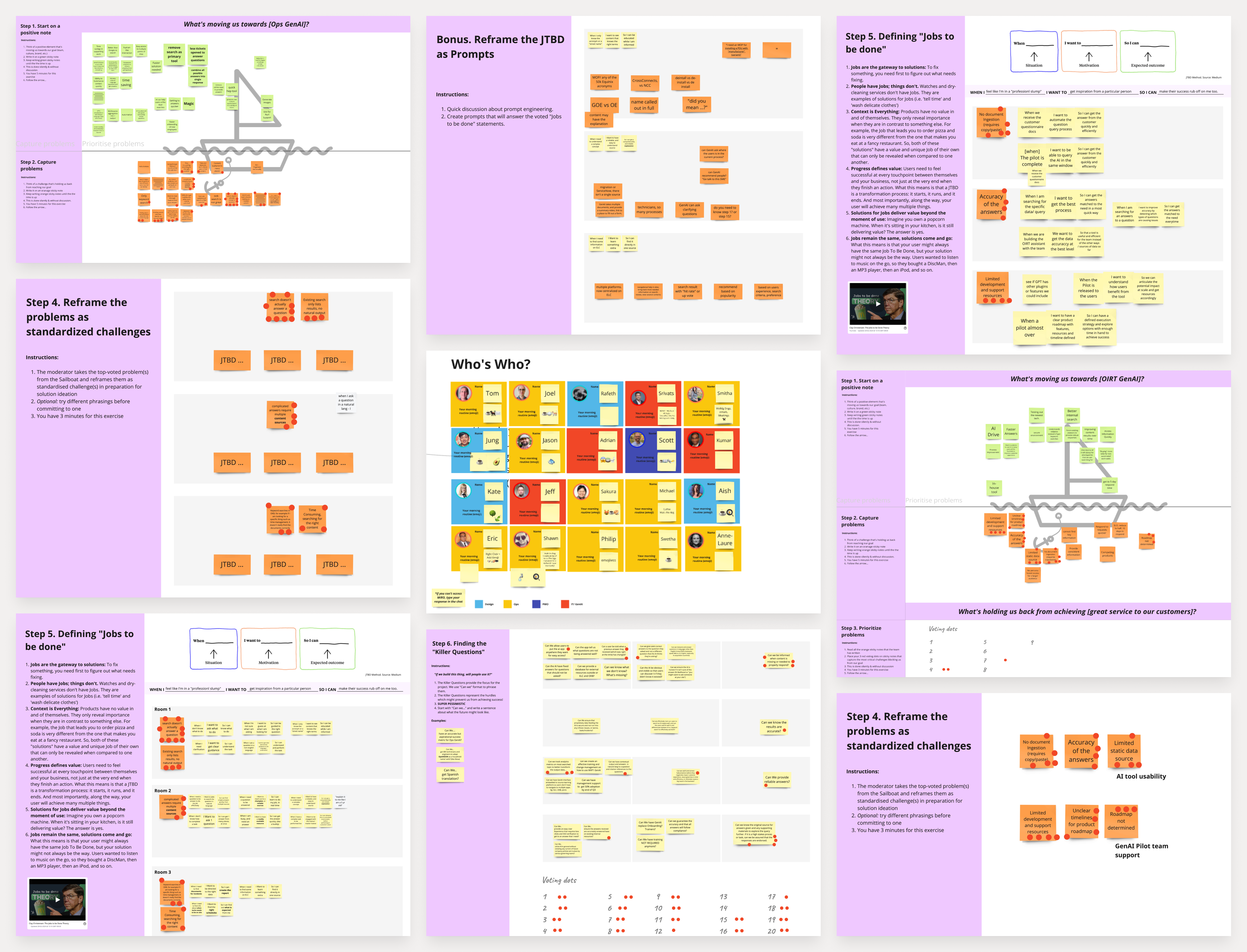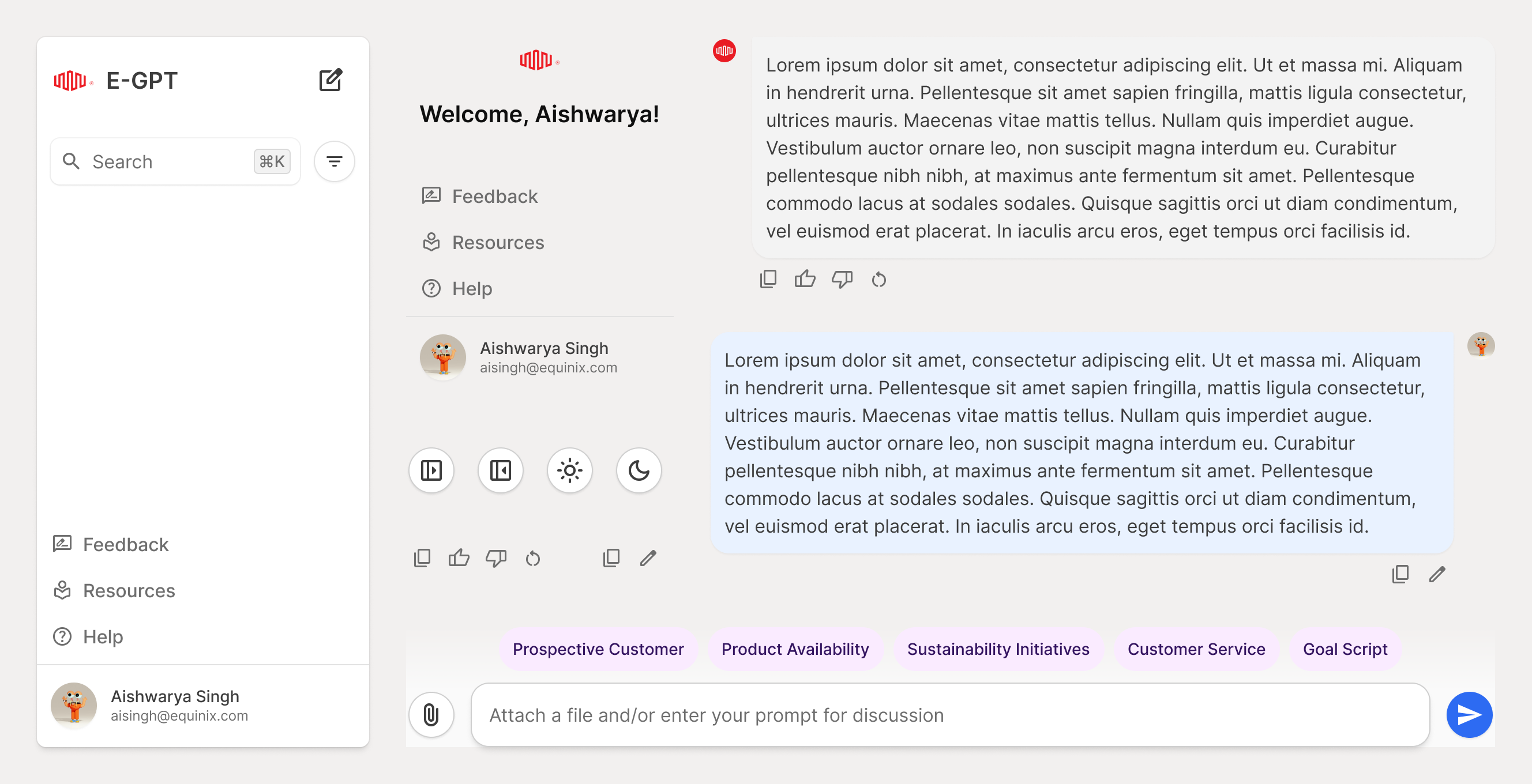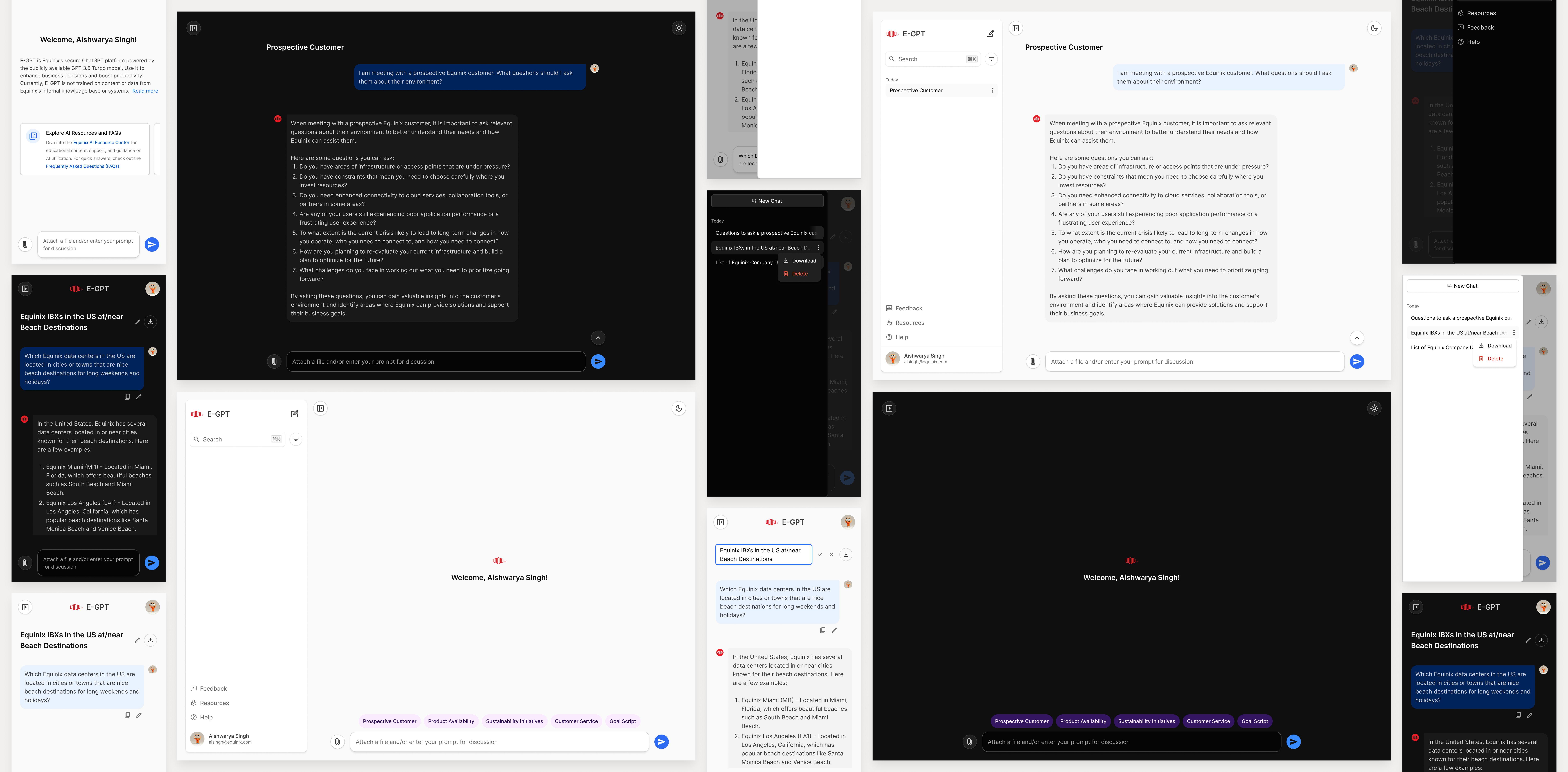E-GPT
Bridging gaps and guiding the internal GenAI initiatives through a shared vision and design concept toward a cohesive, all-employee GPT experience – the Equinix-GPT (E-GPT).
COMPANY
ROLE
Lead Designer
TIMELINE
Jan 2024 - May 2024
TOOL
Figma • Miro • Dovetail
KEY
UX Design • UX Research • User Interview • Sentiment Analysis • Design System • GPT Chatbot • AI • ML • Business Strategy • Agile
ABOUT EQUINIX
Equinix is a global leader in digital infrastructure, empowering businesses to accelerate their digital transformation and thrive in an interconnected world. Founded in 1998, Equinix operates a vast network of over 200 data centers across 55 markets in 27 countries, providing secure, reliable, and high-performance colocation and interconnection services. Their platform enables businesses to directly connect with a diverse ecosystem of partners, customers, networks, and cloud providers, optimizing performance, security, and scalability.
As the backbone of the digital economy, Equinix supports industries ranging from cloud and telecommunications to finance, healthcare, and content delivery. By offering flexible, carrier-neutral environments and low-latency connections, Equinix helps companies unlock new business opportunities, enhance operational efficiency, and future-proof their infrastructure in an increasingly digital-first world. Through its commitment to sustainability, Equinix is shaping the future of global connectivity and driving the growth of the digital transformation ecosystem.
OPPORTUNITY
In keeping up with the GenAI curve, the Enterprise Architecture team at Equinix, in a collaborative effort with the Sales team, Operations Information Request team, and Operations Enablement team, developed internal domain-specific GPT pilot applications.
These GPT solutions, uniquely trained to assist employees with their respective domain-specific queries on Equinix's internal knowledge database, stood out for their ability to generate summaries and translations, debug code, optimize performance, and more.
PROBLEM STATEMENT
The product and engineering teams prioritized building functional prototypes of the various business domain-specific GPT pilot applications before involving the design team. Without early design input, the product lacked intuitive usability, visual cohesion, and alignment with user needs and behaviors. The result was delays and increased costs in later stages due to necessary rework, misaligned features, or friction in user interactions.
The absence of user experience design from the beginning prevents critical user-centered decisions that ensure the product is not only functional but also engaging, accessible, and aligned with the end user's expectations.
DESIGN CONCEPT & VISION
As the design lead, I inspired and guided the GenAI initiatives through a shared vision and design concept toward a cohesive, all-employee GPT experience – the Equinix-GPT or E-GPT.
The envisioned singular GPT application would answer queries encompassing every internal business domain, thus improving the Employee Experience on mobile and desktop.
DISCOVERY & RESEARCH METHODS
Design Workshops
Design System
Mobile-first Design Philosophy
Open-ended User Interviews
Prototype Testing
Sentiment Analysis
DESIGN WORKSHOPS
Utilizing a human-centered design approach, we organized design workshops with Equinix's various business domain teams. This approach, which places the user at the heart of our design process, allowed us to co-create the best user experience and align the vision of one coherent all-employee GenAI application.
I. Jobs to be Done
Using the 'Jobs to be Done' framework, a customer-centric approach that focuses on the core tasks users are trying to accomplish with a product, we asked: 'What job or unique task is the GenAI tool enabling users to perform?'
This approach helped us align the problem statements and primary use cases for initial product development, ensuring that the GenAI tool was designed to meet the specific needs of our users.
II. Killer Questions
Further, we used the 'Killer Questions' method to identify potential hurdles that might derail product implementation and prevent successful completion.
These questions, designed to challenge assumptions and uncover potential issues, were answered by the business domain teams through a hypothesis > design > prototype > test, helping us anticipate and address potential problems early in the product conceptualization.

Design Workshops
IMPLEMENTATION MODEL
- Intent recognition would establish the domain and context of the query and, if required, seek further clarification from the user.
- The GPT orchestrator would direct the query to the appropriate domain API.
- Advanced orchestration capabilities would extract data from multiple domain APIs, providing a consolidated response to the user.
- Guided prompt experiences would allow users to narrow the context of their query from curated domain-specific prompts.
- On receiving a response to their query, users could proceed to the following query with context from any domain.
NEED FOR A NEW DESIGN SYSTEM
A new and dedicated design system was custom-created for the GPT application, which focused on the unique interaction patterns, components, and design guidelines required to support a sophisticated AI-powered tool for internal employees. The tailored design system ensured improved consistency, reduced development time, and enhanced overall usability.
I. Unique User Interactions
The GPT application introduced new types of interactions and workflows not covered by the pre-existing design system. Features like natural language input, dynamic responses, and conversational interfaces needed tailored components and guidelines to ensure consistency and usability across the platform.
II. Lack of Relevant Components
The pre-existing design system did not offer the necessary UI components for the unique features of a language-based application, such as chat interfaces, AI-driven suggestion modules, or contextual tooltips. This gap meant the design would need to create custom solutions from scratch, leading to inefficiencies and inconsistencies.
III. Scalability and Flexibility
The GPT application was expected to scale rapidly and evolve as more features and use cases were added. The pre-existing design system lacked the flexibility to support this type of growth, particularly in creating reusable, scalable components for a complex, interactive tool.
IV. Brand Consistency and Cohesion
With the GPT application being an all-employee internal tool, it was essential to create a design system that aligned with the company's branding guidelines while accommodating the novel nature of the application.

Design System Components
MOBILE FIRST = CONTENT FIRST
- Mobile-first design philosophy prioritizes designing for small-screen experiences and is one of the finest methodologies for building responsive and adaptive solutions.
- Since mobile design has constraints like screen size and bandwidth, designing within these parameters naturally leads to content-focused design.
- One caveat is that mobile users may sometimes require content and functionality different from those of desktop or tablet users.
- Considering the context of 'what' users value more in a given scenario and environment can help gauge and assess the need for device-specific content.

Mobile-first Design Philosophy
SENTIMENT ANALYSIS & ITS ADVANTAGES
Next, we conducted a Sentiment Analysis of E-GPT with five active beta users of the previously built functional prototype. The System Usability Scale (SUS) was used for quantitative analysis to measure the user experience before and after the design of E-GPT. Also, perception-based qualitative analysis through open-ended interviews helped capture the sentiments of Customer Satisfaction (CSAT), product, and usage.
- Sentiment Analysis goes beyond the number of views and clicks and focuses on the quality of user experience and interaction with the product.
- It helps understand the 'why' behind users' responses since emotions, feelings, or opinions are subject to change from person to person.
- It assists in learning what users feel about the competition, allowing the business to re-evaluate priorities and stay one step ahead.
- It identifies early signs of trends and users' positive or negative responses to them.
KEY TAKEAWAYS & IMPACT
93.0
System Usability Scale (SUS)
E-GPT gained 21 points on SUS, scoring 93, versus 72 on the functional prototype. The notable improvement is a testament to the design's success.
88%
Customer Satisfation (CSAT)
The mobile-first design was exceptionally well received, and the overwhelming interest in using E-GPT on mobile devices validated the design approach.
1800+
Early Adopters in Week 1
User interaction was more conversational, with heavy usage focused on language translation, drafting emails, and professional-sounding communication.
LEARNINGS FOR THE FUTURE
Potential feature concepts for the future E-GPT user experience may include:
- Personalized custom prompts enabled by user profile awareness and identified user scenarios.
- Quick language translation options.
- Voice command and hands-free interaction.
- Integration with enterprise applications like Microsoft Outlook, Teams, PowerBI, and SharePoint.
"The best way to predict the future is to create it." – Peter Drucker
Let's shape the future together!
CONNECT
© 2025 Aishwarya Singh